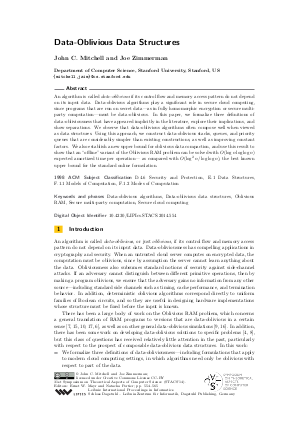Data-Oblivious Data Structures
Authors John C. Mitchell, Joe Zimmerman
-
Part of:
Volume:
31st International Symposium on Theoretical Aspects of Computer Science (STACS 2014)
Part of: Series: Leibniz International Proceedings in Informatics (LIPIcs)
Part of: Conference: Symposium on Theoretical Aspects of Computer Science (STACS) - License:
 Creative Commons Attribution 3.0 Unported license
Creative Commons Attribution 3.0 Unported license
- Publication Date: 2014-03-05
File

PDF
LIPIcs.STACS.2014.554.pdf
- Filesize: 0.58 MB
- 12 pages
Document Identifiers
Subject Classification
Keywords
- Data-oblivious algorithms
- Data-oblivious data structures
- Oblivious RAM
- Secure multi-party computation
- Secure cloud computing
Metrics
- Access Statistics
-
Total Accesses (updated on a weekly basis)
0Document
0Metadata
Abstract
An algorithm is called data-oblivious if its control flow and memory access pattern do not depend on its input data. Data-oblivious algorithms play a significant role in secure cloud computing, since programs that are run on secret data—as in fully homomorphic encryption or secure multi-party computation—must be data-oblivious. In this paper, we formalize three definitions of data-obliviousness that have appeared implicitly in the literature, explore their implications, and show separations. We observe that data-oblivious algorithms often compose well when viewed as data structures. Using this approach, we construct data-oblivious stacks, queues, and priority queues that are considerably simpler than existing constructions, as well as improving constan factors. We also establish a new upper bound for oblivious data compaction, and use this result to show that an "offline" variant of the Oblivious RAM problem can be solved with O(log(n).log(log(n))) expected amortized time per operation - as compared with O(log^2(n)/log(log(n))), the best known upper bound for the standard online formulation.
Cite As Get BibTex
John C. Mitchell and Joe Zimmerman. Data-Oblivious Data Structures. In 31st International Symposium on Theoretical Aspects of Computer Science (STACS 2014). Leibniz International Proceedings in Informatics (LIPIcs), Volume 25, pp. 554-565, Schloss Dagstuhl – Leibniz-Zentrum für Informatik (2014)
https://doi.org/10.4230/LIPIcs.STACS.2014.554
BibTex
@InProceedings{mitchell_et_al:LIPIcs.STACS.2014.554,
author = {Mitchell, John C. and Zimmerman, Joe},
title = {{Data-Oblivious Data Structures}},
booktitle = {31st International Symposium on Theoretical Aspects of Computer Science (STACS 2014)},
pages = {554--565},
series = {Leibniz International Proceedings in Informatics (LIPIcs)},
ISBN = {978-3-939897-65-1},
ISSN = {1868-8969},
year = {2014},
volume = {25},
editor = {Mayr, Ernst W. and Portier, Natacha},
publisher = {Schloss Dagstuhl -- Leibniz-Zentrum f{\"u}r Informatik},
address = {Dagstuhl, Germany},
URL = {https://drops.dagstuhl.de/entities/document/10.4230/LIPIcs.STACS.2014.554},
URN = {urn:nbn:de:0030-drops-44876},
doi = {10.4230/LIPIcs.STACS.2014.554},
annote = {Keywords: Data-oblivious algorithms, Data-oblivious data structures, Oblivious RAM, Secure multi-party computation, Secure cloud computing}
}
